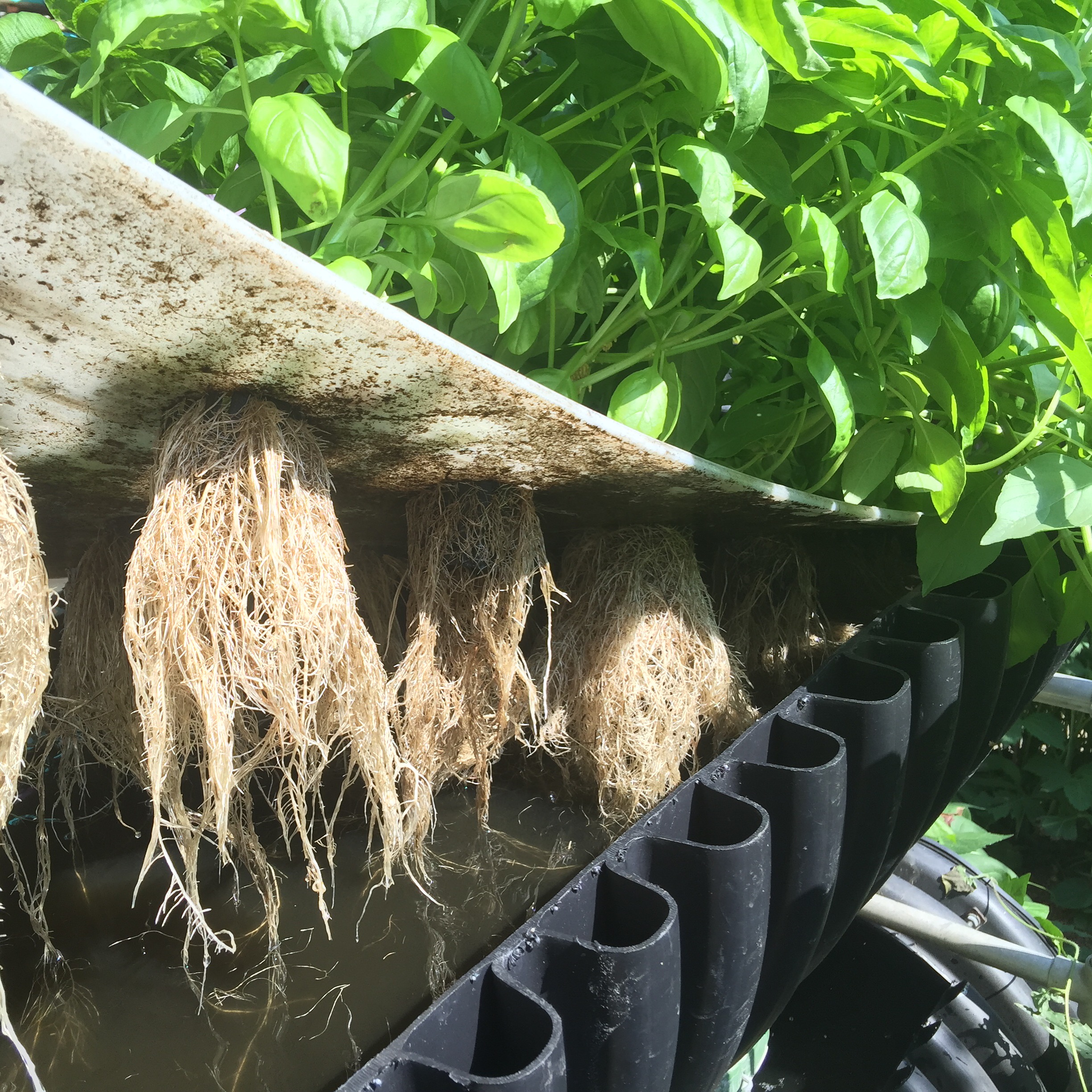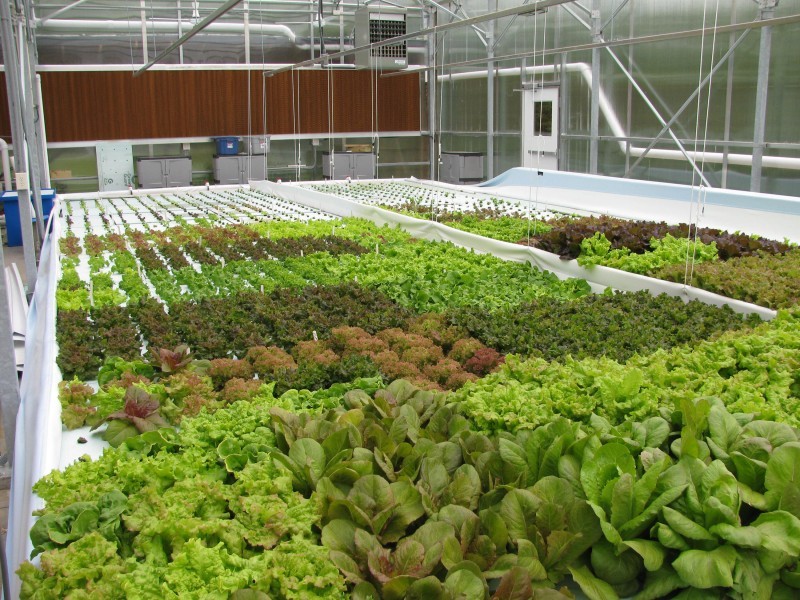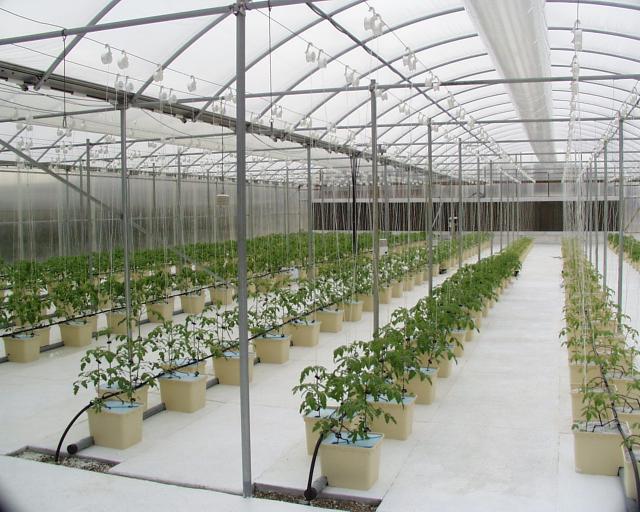ALT, A Deep Water Culture Alternative
Deep Water Culture in a 40' Biogarden Trough
The Biogarden consists of narrow 18" wide concave bed. It is not entirely dissimilar to using dutch buckets or other containers in process, but moreso in design. The air layer below is a unique feature that the Biogarden trough provides.
Enhanced Plant Nourishment with this ALT Deep Water Culture System method.
In an organic growing environment as pictured here within the Biofarm the deep water culture system requires a balance of organics and microbes. The released of inorganics by microbes, is much like with the function of fish in aquaponics,
Nutrient and water transport lines always remain clear in the Biogarden design while maintaining a sensitive ecosystem comprised of microbes and other organism facilitating the nutrient cycling process in harmony with the plants.
Prior to adding our organic liquid fertilizers to the deep water Biogarden trough, the nutrients from dry biomass blends are extracted via both anaerobic digestion and then into a Nutricycler, or aerotic vortex biofiltration.
If not set up for deep water, a Biogarden may be configured for aggregate beds. The liquid nutrients from anaerobic extraction require somewhat less prep with nutricycling or biofiltration as the aggregate beds and their robust colony of microbes, manage this process.
Biofiltration reduces carbon, nitrifies ammonia and creates more plant-ready nutrients.
Key Design and Operating Features of the Biogarden
Concave Trough

The concave shaped trough wedges the raft into place so that as the water level rises and falls, an air layer is created at the upper root zone. With each rise and fall in water level nutrients, oxygen and hydration are provided to the microbes on the roots.
Air Layer Technique

The ebb and flow of water to the bottom of the raft forces CO2 with fresh oxygen in the air layer space. In an organic environment this stabilizes microbial colonization on the roots and therefore the nutrient conversion from carbon rich to a more ionized plant ready form.
Biogarden Air Layer Technique
Flooding and partially draining the water to the level of the plant, the Biogarden behaves like a bay, nourishing and hydrating roots when the level rises.
When the level drops and roots are exposed, the air layer oxygenates the roots and supports a biological ecosystem to help with filtration. Water flows continuously during the flow cycle and never fully drains during ebb cycle.
This cycling makes it possible for plants to become their own biofilter facility, with aerobic microbes binding to the roots, consuming organics that are part of the nutritious cycle for plant growth. The results speak for themselves.
Advantages of Biogarden Deep Water Culture System vs Other Hydroponic Growing Systems
Pro's:
- Supports organic environment
- No mechanical aeration costs
- On off pump and gravity flow reduces water movement costs
- No salt buildup from minerals
- Supports variety of small or large plants.
- Water transfer from one end to the other with each cycle ensures steady water exchanged.
- May be used to raise other aquatics including spirulina, duckweed, filter feeding fish and crustaceans.
- Supports organic hydroponics (and inorganic chem based) growing
- Waist height grow beds for easy handling
- Stackable for multiple vertical grow levels
- Optional tank below for fish or closed modular nutrient cycling
- HDPE food grade, carbon black troughs are stable and have minimal plastic leaching
Con's:
- More water must be maintained will require higher amount of nutrient inputs to reach appropriate nutrient concentrations.


Compared to Other Hydroponics Systems and Techniques
The various systems for growing plants in soilless basis have advantages and disadvantages. Most are designed for use with chemical fertilizers, but may be adapted to organics when proper biofiltration and microbe favorable conditions are set up.
With aquaponics growing systems rafts and NFT techniques may be used. Typically though, for growing heavy feeding plants, supplemental minerals and phosphorus must be added. Typically this is done from inorganic mined mineral salts.
Chemical based techniques may be somewhat less expensive with nutrients and with infrastructure to, but there is also less variability with plants grown and soilless technique
Rafts with Aquaponics or Chemical Fertilizers

Pros
- Good for lettuces and green leafy plants that require very little maintenance during short grow cycles
- Relatively stable with respect to nutrient fluctuations
- Stable with respect to temporary power loss.
- Movement of plants makes for efficient operation with handled properly
Cons
- Expensive energy inputs for adquate water movement.
- Requires expensive air bubblers or air pocket under roots.
- Plastic walls and styrofoam rafts not good environmentally
- Use of chemical fertilizers or mineral salts not ideal
- Requires large volume of water to be kept at adequate nutrient levels
- Cannot manage plant trays within center of growing tank until all trays are moved forward
Gutter Troughs with Chemical NFT

Pros
- Good for natural aeration
- Good for limited water environments as trickle is most conservative with water
- Efficient use of space
Cons
- Trays are PVC which is not a partcularly good plastic for raising plants
- Roots and biofilm obstruct troughs when not properly maintained or when growing larger rooting plants.
- Difficult to clean root debris from troughs between seasons and harvests.
- Often large anaerobic or biofilm zones impede plant growth.
- Not well suited to organic fertilizers without heavy buildup in troughs or narrow fertigation lines.
- Plastic breaks down and has to be replaced periodically
Dutch Buckets with Chemical Fertilizers

Pros
- Inexpensive setup.
- Easy to replace or add new
- Efficient use of space
Cons
- Plants all maintained on single nuitrient source
- Vulnerable to systemic nutrient imbalance or pH change
- Plumbing cannot support organic without clogging easily
- Not particularly versatile for growing numerous varieties of plants
- Requires a considerable amount of effort to set up
- More prone to disease due to stagnation and algae builup in bottoms of buckets
- Sudden death situations with no clear cause. May be due to chemical imbalances as most are inorganic setups.
